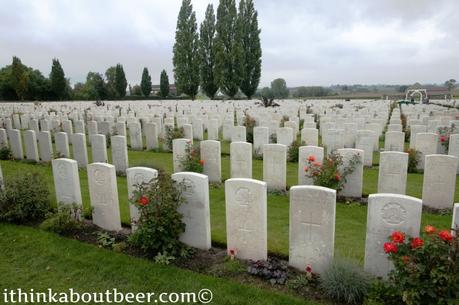 One of the monks, Brother Victor Van Staten, wrote in his journal of the cramped quarters at the abbey among the French troops in 1914. "Powder cars, rifles in piles or standing against the wall, officers here, captains or sergeants there; buildings, attics, barns, cowshed, everything is full of soldiers," wrote Van Staten. "The brothers are almost unable to milk the cows; even the space between the cows is full." Once the French moved out in the spring of 1915, the British forces took over the area surrounding the abbey. With the British, rules were strict, but there were far fewer soldiers billeted inside the abbey walls. Officers and their support staff were stationed inside, while the majority of troops were camped in the surrounding fields and woods. The monks did take advantage of the British love of beer. "The beer in the cellar of the guest house is sold to the soldiers," wrote Van Staten in his journal. "We were doing good business, but the word came from the General that too much noise was being made and caused a disturbance in the big office which was above the cellar. So, they had to see where to move the canteen to now." The monks of Westvleteren, the only Belgian abbey that wasn't occupied by the Germans, were the only Trappists able to brew throughout the war. The abbey and its monks, however, didn't make it out completely unscathed... From the fall of 1914 through the end of the war in 1918, thousands of troops were stationed at the abbey.
One of the monks, Brother Victor Van Staten, wrote in his journal of the cramped quarters at the abbey among the French troops in 1914. "Powder cars, rifles in piles or standing against the wall, officers here, captains or sergeants there; buildings, attics, barns, cowshed, everything is full of soldiers," wrote Van Staten. "The brothers are almost unable to milk the cows; even the space between the cows is full." Once the French moved out in the spring of 1915, the British forces took over the area surrounding the abbey. With the British, rules were strict, but there were far fewer soldiers billeted inside the abbey walls. Officers and their support staff were stationed inside, while the majority of troops were camped in the surrounding fields and woods. The monks did take advantage of the British love of beer. "The beer in the cellar of the guest house is sold to the soldiers," wrote Van Staten in his journal. "We were doing good business, but the word came from the General that too much noise was being made and caused a disturbance in the big office which was above the cellar. So, they had to see where to move the canteen to now." The monks of Westvleteren, the only Belgian abbey that wasn't occupied by the Germans, were the only Trappists able to brew throughout the war. The abbey and its monks, however, didn't make it out completely unscathed... From the fall of 1914 through the end of the war in 1918, thousands of troops were stationed at the abbey. Sunday November 11, 2018 was the 100th anniversary of the end of World War I, also known as Armistice Day or Veterans Day. The Trappist Abbey of Westvelteren was the only Trappist monastery of the five in Belgium (Orval wasn't founded until after the war) that wasn't behind German lines throughout the war. Instead, the monks of Westvleteren lived side by side with first the French then the British forces that used its proximity to the front as a base. The above text is from an article I wrote about the brewing industry in France and Belgium during and after World War I. You can read the full text here.
To mark the anniversary, I opened the fourth bottle of Westvleteren 12 from the batch I set aside for The Brux Project since the timing worked out perfectly: bottle no. 4 to commemorate the end of 4 years of war opened on 11/11/2018.
Appearance: Brown, light haze, tan head, great retention.
Aroma: Cocoa, spice, tobacco, leather, figs, dates, dark toast,
Taste: Bitter chocolate. rye bread, dark rum
Overall impression: At just over two years old, the beer has shed the last of its new "bite" and is starting show its more yeast and aged characteristics. The rich maltiness has become the star along with the aged dry fruit character and the yeasty spiciness. It has a nice warming hit of booziness. The flavors are still big and rich and at a really nice development stage from the "new" Westvleteren flavor.
Availability: Very rare, only available directly from the abbey.
You can read about the other Westvelteren 12 tastings in this series here.10.2% ABV
You can read about the history of the abbey, beer reviews, and my trip to their shop In De Vrede on my Westvleteren Page.

